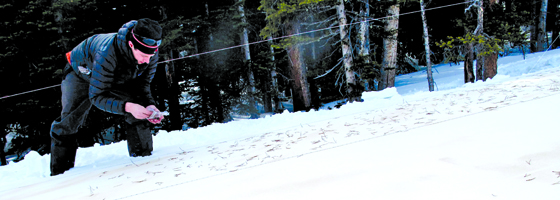Colorado researchers believe debris increases snowmelt

A skiing enthusiast, Danielle Perrot has understandable concern for the condition of her recreational surface. If the snow is too dirty, it sticks to the skis. If it melts too early, the ski season ends prematurely. If the mountain pine beetle infestation spreads, trees fall on the slopes, hopefully missing skiers. There is a lot to think about other than enjoying the slopes.
Conveniently, Perrot is an alpine researcher at the University of Colorado-Boulder studying the effects of dust and pine needles on snowmelt. Pure white snow easily reflects solar rays, preventing it from melting quickly. When debris falls on snow, it reduces the snow’s albedo, a measure of the snow’s ability to reflect light. Reducing the albedo increases the amount of energy absorbed rather than reflected, which causes the snow to melt more quickly. Aside from cutting the ski season short, it affects hydrology in nearby streams and rivers.
In the western United States, including the Rocky Mountain region and California, a majority of the water flowing in rivers and streams originates from snowmelt. Normally, thick snowpack acts as a drip irrigation system, slowly melting and releasing water from the natural reservoir. Those who depend on this water, such as farmers in California and Arizona, expect a high flow in June and July, as this is when most of the snow is melting. However, when snow melts sooner, reservoirs downstream are not expecting the sudden influx of water. Water schedules are thrown out of sync, affecting soil moisture, productivity, and biologic activity.
Perrot’s research will study how dust and pine needle contaminants affect the timing of snowmelt. It will eventually be incorporated into snow models that currently lack snowpack contamination data.
“Everybody thinks albedo is really high in snow and that this high albedo lasts long into the season,” said Evan Pugh, a member of Perrot’s research team. “Almost everywhere we’ve looked in Colorado there is stuff in the snow. During snowmelt, most snow surfaces are not as pure as conceptual models predict. “
Impurities come from both local and distant sources. In recent years, western states have been fighting with an outbreak of the mountain pine beetle. The native beetles burrow into pine trees and lay their eggs in the bark, feeding off the trees. Though they are no bigger than a fingernail, these beetles kill millions of acres of trees during outbreaks. These dead trees drop their needles, littering the snow and lowering its albedo. In Pugh’s research, he found that snow under dying trees melted one week earlier than snow under live trees.
Dust from the Southwest United States is also a culprit in reducing snow’s albedo. Perrot is one of the first researchers to study the effects of dust deposition on snowpack in subalpine forested areas, though she said many people know about it.
To study the effects of this debris on snowmelt, Perrot and her team created a plot in a clearing near Boulder, Colorado. Snowpack is measured in four different 1 meter by 15 meter areas: needle contamination, dust contamination, needle and dust contamination and a control area with no contamination. The team collected some of the dust by crushing their own rocks; some of it came from a local landscaping company.

NexSens micro-T
The team placed NexSens micro-T temperature loggers in pits at each corner and two midpoints of the plot to record long-term temperature measurements. In each pit, a micro-T was placed near the surface, halfway down and three-fourths the distance from the surface of the pit for full-profile temperature data. They also placed loggers in nearby dead trees at varying heights to record air temperature. The micro-Ts will record temperatures every hour, telling Perrot exactly when the snow starts melting and when it becomes isothermal at 0 degrees Celsius.
To measure albedo, the team used an albedometer. This is a contraption made of two pyranometers that measure shortwave radiation. One faces up to measure radiation from the atmosphere while the other faces down to record radiation reflected by the snow. Albedo is calculated as the ratio of reflected radiation to incoming atmospheric radiation. The team assumes that radiation not reflected by the snow is absorbed, heating the snow and starting the melting process.
From preliminary observations, Pugh and Perrot said the plot that contains both dust and needles is melting the fastest. They will know actual temperatures when they dig up the micro-Ts later this year.
“It’ll be like Christmas!” Perrot said. “We’ve been patient all season and now I want my data.”
Perrot will use the data from this winter to create a computer model of the field manipulation experiment. This year, Perrot will not collect as much data as she was hoping to due to the “funky” snowfall. There was very little precipitation in Boulder during the month of March. She and the team will perform the experiments over the next few years to accumulate different data for an average.
“Nature’s always tough,” Pugh said. “When you’re working in a natural system, [research] depends on when it snows, if the temperatures are average or abnormally warm or if a moose walks across the field site and leaves footprints.”
The team did install a fence around the plot to discourage Pugh’s third research variable. Perrot will incorporate the snow contamination data into existing models, providing a more accurate model of snowmelt. From these models, water managers in the western U.S. will have a better idea of how to distribute water over the summer so municipalities and farmers won’t go dry in September. The National Oceanic and Atmospheric Administration and Intergovernmental Panel on Climate Change could also use the modeling in their weather and climate data.
It’s also useful information for recreational companies, including rafting organizations and, of course, ski resorts.
“Anyone that uses water in the western states should care about when the snow melts,” Pugh said.




0 comments